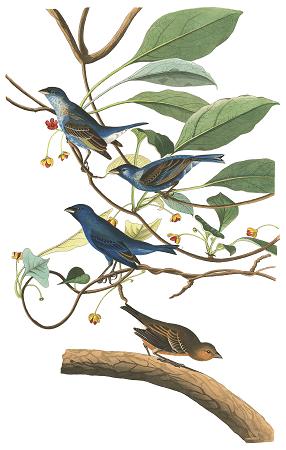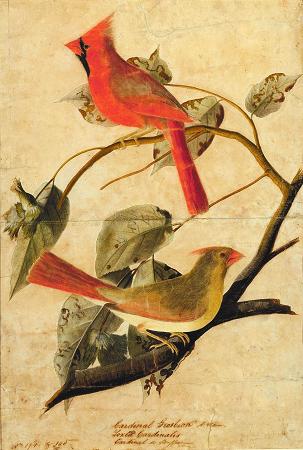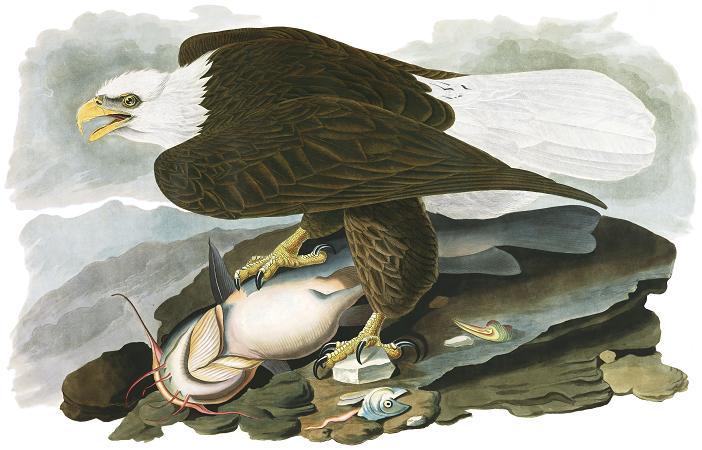Indigo Bunting (c1833). Etching, watercolor. 100 x 65. The indigo bunting is a small seed-eating bird in the family Cardinalidae or cardinal. It is migratory, ranging from southern Canada to northern Florida during the breeding season, and from southern Florida to northern South America during the winter. It often migrates by night, using the stars to navigate. Its habitat is farmland, brush areas, and open woodland. The indigo bunting is closely related to the lazuli bunting and interbreeds with the species where their ranges overlap. The indigo bunting is a small bird, with a length of 11.5-13 cm. It displays sexual dimorphism in its coloration; the male is a vibrant blue in the summer and a brown color during the winter months, while the female is brown year-round. The male displays brightly colored plumage during the breeding season to attract a mate. Nest-building and incubation are done solely by the female. The diet of the indigo bunting consists primarily of insects during the summer months and seeds during the winter months. The indigo bunting is included in the family Cardinalidae, which is made up of passerine birds found in North and South America, and is one of seven birds in the genus Passerina. It was originally described as Tanagra cyanea by Linnaeus in his 18th-century work, Systema Naturae. The current genus name, Passerina, is derived from the Latin term passer for true sparrows and similar small birds, while the species name, cyanea, is from the Latin word meaning dark or sea blue. The indigo bunting is closely related to the lazuli bunting and interbreeds with the species where their ranges overlap, in the Great Plains. They were declared to form a superspecies by the American Ornithologists' Union in 1983. However, according to sequencing of the mitochondrial cytochrome-b gene of members of the genus Passerina, it was determined that the indigo bunting and lazuli bunting are not, in fact, sister taxa. The indigo bunting is the sister of two sister groups, a blue and a painted clade. This genetic study shows these species diverged between 4.1 and 7.3 million years ago. This timing, which is consistent with fossil evidence, coincides with a late-Miocene cooling, which caused the evolution of a variety of western grassland habitats. Evolving to reduce size may have allowed buntings to exploit grass seeds as a food source. The indigo bunting is a smallish songbird, around the size of a small sparrow. It measures 11.5-15 cm long, with a wingspan of 18-23 cm. Body mass averages 14.5 g, with a reported range of 11.2-21.4 g. During the breeding season, the adult male appears mostly a vibrant cerulean blue. Only the head is indigo. The wings and tail are black with cerulean blue edges. In fall and winter plumage, the male has brown edges to the blue body and head feathers, which overlap to make the bird appear mostly brown. The adult female is brown on the upperparts and lighter brown on the underparts. It has indistinct wing bars and is faintly streaked with darker markings underneath. The immature bird resembles the female in coloring, although a male may have hints of blue on the tail and shoulders and have darker streaks on the underside. The beak is short and conical. In the adult female, the beak is light brown tinged with blue, and in the adult male the upper half is brownish-black while the lower is light blue. The feet and legs are black or gray. The habitat of the indigo bunting is brushy forest edges, open deciduous woods, second growth woodland, and farmland. The breeding range stretches from southern Canada to Maine, south to northern Florida and eastern Texas, and westward to southern Nevada. The winter range begins in southern Florida and central Mexico and stretches south through the West Indies and Central America to northern South America. It has occurred as a vagrant in Antigua and Barbuda, Barbados, Denmark, Ecuador, Germany, Iceland, Ireland, Netherlands, the Netherlands Antilles, Saint Pierre and Miquelon, Serbia and the United Kingdom. The indigo bunting communicates through vocalizations and visual cues. A sharp chip! call is used by both sexes, and is used as an alarm call if a nest or chick is threatened. A high-pitched, buzzed zeeep is used as a contact call when the indigo bunting is in flight. The song of the male bird is a high-pitched buzzed sweet-sweet chew-chew sweet-sweet, lasting two to four seconds, sung to mark his territory to other males and to attract females. Each male has a single complex song, which he sings while perched on elevated objects, such as posts, wires, and bush-tops. In areas where the ranges of the lazuli bunting and the indigo bunting overlap, the males defend territories from eac
more...





